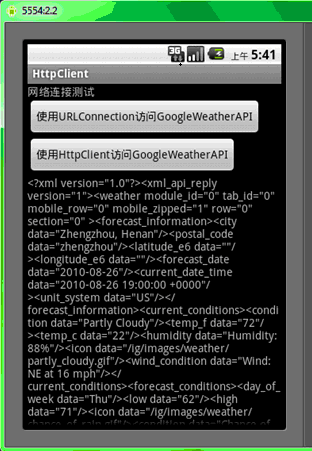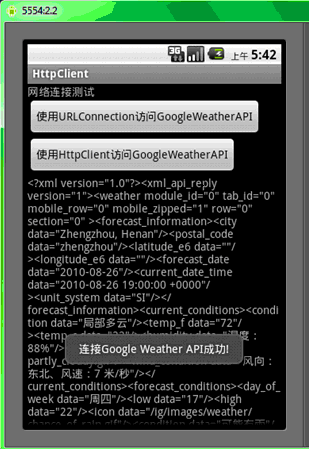上一节讲了使用WebView控件访问网络的方法,而除这种方法之外,我们还可以使用代码的方式访问网络,代码方式在很多时候用起来更灵活。本节要讲的就是使用URLConnection对象和HttpClient组件访问网络的方法。
实际上URLConnection和HttpClient访问网络的方法和Java Web开发中的使用方式几乎没什么区别,而Java Web开发的资料比较多,大家可以在学完本节后去查阅相关资料,深入研究下HttpClient4.0的内容,以学习更多更深的知识。
分别使用URLConnection和HttpClient访问Google天气服务的例子
这个例子的的目的就是从Google哪里获取郑州的天气预报信息,并显示在TextView中,本讲只会把返回的XML数据显示出来,下一讲我们学XML解析的时候再把这个天气预报做成图文并茂的形式,所以大家先暂时忍耐一下丑陋的界面。
1、新建一个项目 Lesson30_HttpClient ,主Activity的文件名是 MainActivity.java。
2、res/layout/main.xml的内容如下:
- <?xml version="1.0" encoding="utf-8"?>
- <LINEARLAYOUT xmlns:android="http://schemas.android.com/apk/res/android" android:layout_height="fill_parent" android:layout_width="fill_parent" android:orientation="vertical">
- <TEXTVIEW android:layout_height="wrap_content" android:layout_width="fill_parent" android:text="网络连接测试" android:id="@+id/TextView01" />
- <BUTTON type=submit android:layout_height="wrap_content" android:layout_width="wrap_content" android:text="使用URLConnection访问GoogleWeatherAPI" android:id="@+id/Button01">
- </BUTTON>
- <BUTTON type=submit android:layout_height="wrap_content" android:layout_width="wrap_content" android:text="使用HttpClient访问GoogleWeatherAPI" android:id="@+id/Button02">
- </BUTTON>
- <SCROLLVIEW android:layout_height="wrap_content" android:layout_width="wrap_content" android:id="@+id/ScrollView01">
- <TEXTVIEW android:layout_height="wrap_content" android:layout_width="wrap_content" android:id="@+id/TextView02">
- </TEXTVIEW>
- </SCROLLVIEW>
- </LINEARLAYOUT>
3、MainActivity.java的内容如下:
- package android.basic.lesson30;
- import java.io.InputStreamReader;
- import java.net.HttpURLConnection;
- import java.net.URL;
- import org.apache.http.client.ResponseHandler;
- import org.apache.http.client.methods.HttpGet;
- import org.apache.http.impl.client.BasicResponseHandler;
- import org.apache.http.impl.client.DefaultHttpClient;
- import android.app.Activity;
- import android.os.Bundle;
- import android.view.View;
- import android.widget.Button;
- import android.widget.TextView;
- import android.widget.Toast;
- public class MainActivity extends Activity {
- TextView tv;
- String googleWeatherUrl1 = "http://www.google.com/ig/api?weather=zhengzhou";
- String googleWeatherUrl2 = "http://www.google.com/ig/api?hl=zh-cn&weather=zhengzhou";
- /** Called when the activity is first created. */
- @Override
- public void onCreate(Bundle savedInstanceState) {
- super.onCreate(savedInstanceState);
- setContentView(R.layout.main);
- // 定义UI组件
- Button b1 = (Button) findViewById(R.id.Button01);
- Button b2 = (Button) findViewById(R.id.Button02);
- tv = (TextView) findViewById(R.id.TextView02);
- // 设置按钮单击监听器
- b1.setOnClickListener(new View.OnClickListener() {
- @Override
- public void onClick(View v) {
- // 使用URLConnection连接GoogleWeatherAPI
- urlConn();
- }
- });
- // 设置按钮单击监听器
- b2.setOnClickListener(new View.OnClickListener() {
- @Override
- public void onClick(View v) {
- // 使用HttpCient连接GoogleWeatherAPI
- httpClientConn();
- }
- });
- }
- // 使用URLConnection连接GoogleWeatherAPI
- protected void urlConn() {
- try {
- // URL
- URL url = new URL(googleWeatherUrl1);
- // HttpURLConnection
- HttpURLConnection httpconn = (HttpURLConnection) url.openConnection();
- if (httpconn.getResponseCode() == HttpURLConnection.HTTP_OK) {
- Toast.makeText(getApplicationContext(), "连接Google Weather API成功!",
- Toast.LENGTH_SHORT).show();
- // InputStreamReader
- InputStreamReader isr = new InputStreamReader(httpconn.getInputStream(), "utf-8");
- int i;
- String content = "";
- // read
- while ((i = isr.read()) != -1) {
- content = content + (char) i;
- }
- isr.close();
- //设置TextView
- tv.setText(content);
- }
- //disconnect
- httpconn.disconnect();
- } catch (Exception e) {
- Toast.makeText(getApplicationContext(), "连接Google Weather API失败", Toast.LENGTH_SHORT)
- .show();
- e.printStackTrace();
- }
- }
- // 使用HttpCient连接GoogleWeatherAPI
- protected void httpClientConn() {
- //DefaultHttpClient
- DefaultHttpClient httpclient = new DefaultHttpClient();
- //HttpGet
- HttpGet httpget = new HttpGet(googleWeatherUrl2);
- //ResponseHandler
- ResponseHandler<STRING> responseHandler = new BasicResponseHandler();
- try {
- String content = httpclient.execute(httpget, responseHandler);
- Toast.makeText(getApplicationContext(), "连接Google Weather API成功!",
- Toast.LENGTH_SHORT).show();
- //设置TextView
- tv.setText(content);
- } catch (Exception e) {
- Toast.makeText(getApplicationContext(), "连接Google Weather API失败", Toast.LENGTH_SHORT)
- .show();
- e.printStackTrace();
- }
- httpclient.getConnectionManager().shutdown();
- }
- }</STRING>
4、最后别忘了在AndroidManifest.xml中加入访问网络的权限:
- <uses-permission android:name="android.permission.INTERNET"></uses-permission>
5、运行程序查看结果:

按第一个按钮的效果,返回的数据结果显示在了TextView里:

按第二个按钮的效果,返回的数据结果显示在了TextView里, 所不同的是显示的是中文。
本节就讲到这里了,相信大家对URLConnection和HttpClient访问网络的知识有了初步了解。